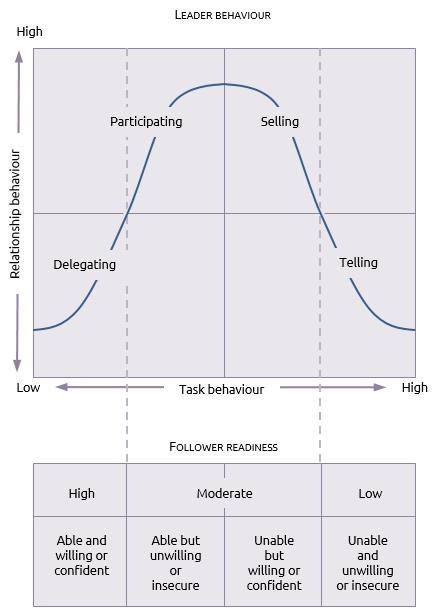Paul Hersey and Ken Blanchard first developed their ‘Life cycle theory of leadership’ in 19691. They subsequently renamed the theory ‘situational leadership’ and continued to develop it both together and individually.
The theory describes four different leadership styles and four levels of individual or team maturity or readiness. It then combines these to suggest which style of leadership best suits which level of maturity.
The leadership styles are:
S1: Telling.
This style is characterised by one-way communication where the manager defines roles and is very directive about how work will be performed.
S2: Selling.
The manager is still providing direction but is using two-way communication. The team or individual is now encouraged to buy into the decisions being made by the manager.
S3: Participating.
The manager and team (or individual) share the decision making about some aspects of how the work will be performed. The manager is focusing less on directive behaviour and more on supportive behaviour.
S4: Delegating.
While still involved in decisions, the manager has delegated much of the responsibility for performance of the work to the team or individual but retains responsibility for monitoring progress.
A P3 manager needs to be competent in all four styles. While ‘S1’ may be appropriate where a project manager has enlisted help from a short term contractor, ‘S4’ is very much the relationship that should be seen between, for example, a programme manager and project manager.
These styles correlate to points on Tannenbaum and Schmidt’s leadership continuum and can also be easily aligned with the stages in Tuckman’s model of team development.
Alongside the leadership styles are the characteristics of the team or individual. In the earlier version of the model this was called ‘levels of maturity’ but in later versions this became ‘follower readiness’. The four levels of readiness are:
R1: Unable and unwilling or insecure.
R2: Unable but willing or confident
R3: Able but unwilling or insecure
R4: Able and willing or confident
Putting the leadership styles together with the levels of readiness results in the diagram below:

- Telling
-
When the team member first arrives there may be anxiety, tension or confusion. The manager should adopt a task oriented approach, providing specific instructions and closely supervising performance.
- Selling
-
As individuals begin to understand what is required the manager will spend more time establishing a relationship of trust and mutual understanding. Since the individual may not yet have developed sufficient competency to assume full responsibility for the task it is still necessary to explain decisions and provide opportunity for clarification.
- Participating
-
As the individual develops high levels of competency and motivation, greater delegation and group decision making is possible. The leader concentrates on developing relationships with individuals.
- Delegating
- Finally a point is reached where team members are confident in their ability, trusted to get on with the task and have a good relationship with the manager. Both task and relationship behaviour drop to low levels. Complacency on the part of the manager is now, perhaps, the greatest danger.
- Hersey, P. and Blanchard, K.H., Life cycle theory of leadership, Training and Development Journal, 23 (5), (1969)





